We’re willing to venture a guess that your vacation on a Carnival cruise is something you look forward to all year. And since the sun will be shining no matter where you are — whether you plan to cruise the Caribbean, take in the historical sites of Europe, hop the islands of Hawaii or discover the stunning magnificence of Alaska — you’ll want to bring some good sunscreen along to protect your skin from the sun’s rays, so you can stay comfortable and have plenty of fun.
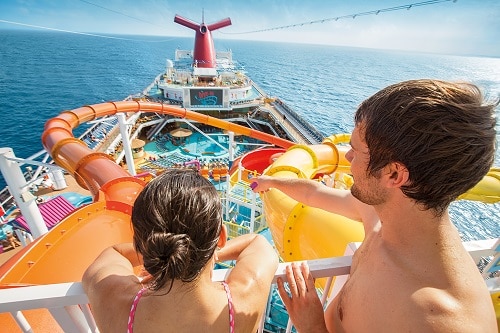
To cover yourself during your cruise, we’ve gathered some tips to help you choose the best sunscreen for your destination. And depending on where you’re headed, you may want to bring along two types of sunscreen: one for onboard outdoor activities and one for shore excursions.
Demystifying SPF and UV Ratings
The SPF (sun protection factor) rating on your sunscreen lets you know how long the sun’s UV (ultraviolet light) radiation would take to begin affecting your skin when it’s covered with the sunscreen. SPF ratings range anywhere from under 10 to 100.
Many cruise destinations are super sunny with high UV index ratings, so it makes sense to think you need a sunscreen with the highest SPF number possible. In general, all you really need is an SPF of 30 or higher, according to the American Academy of Dermatology (AAD), but you may want a higher SPF rating if you are fair-skinned or plan to take advantage of hours at the beach, on deck or in the water.
The number next to the letters “SPF” on your sunscreen bottle indicates how many times longer the sun will take to burn your skin than if you weren’t wearing any sunscreen at all. For example, skin covered with SPF 15 takes 15 times longer to burn than uncovered skin, and SPF 100 takes 100 times longer.
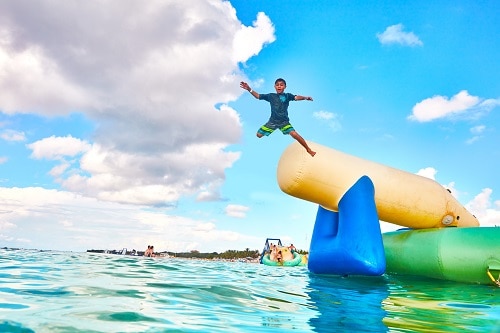
Now, what about those UVB rays?
The two types of ultraviolet light, UVA and UVB, affect your skin in different ways. UVB rays are what SPF ratings are based on because they are the type of ultraviolet lights that cause sunburn and can lead to skin cancer. So a higher SPF rating gives you more protection.
But if you also want to protect your skin from wrinkling and age spots typically caused by UVA rays, get a broad-spectrum, or full-spectrum sunscreen for the best overall skin protection. As far as protecting you from the sun’s UVB rays, here’s the skinny as explained by the American Cancer Society:
- SPF 15 filters out 93 percent of the sun’s UVB rays
- SPF 30 filters out 97 percent of the sun’s UVB rays
- SPF 50 filters out 98 percent of the sun’s UVB rays
- SPF 100 filters out 99 percent of the sun’s UVB rays
No matter what SPF rating you choose, it’s important to reapply every two hours or right after you take a dip in the onboard pool or off the shores of your balmy cruise destination. That way, you’re always protected no matter what activity or leisure time you’re enjoying.
Sunscreens for Kids
When it comes to the best sunscreen for kids on a cruise, the choice is pretty straight forward. Stick to sunscreen with the word “baby” on the bottle or tube. That generally means that the sunscreen contains only titanium dioxide and zinc oxide (check the list of ingredients to be sure); both ingredients are minerals and less likely to irritate a child’s skin.
The AAD does not recommend sunscreen for babies under six months, however. Instead, protect your infant’s delicate skin with soft, wide-brimmed caps and light clothing that covers the body, arms and legs.
And keep your little one in the shade of an umbrella or covered carrier or stroller as much as possible while enjoying your outdoor fun.
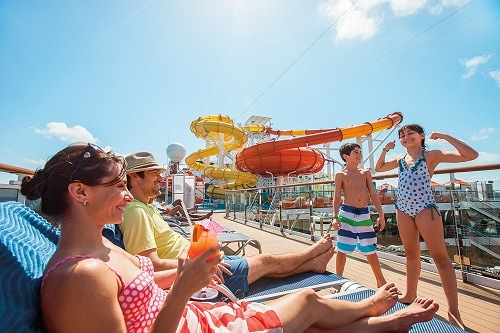
Go for Water-Resistant Sunscreen
For cruising, look for a water-resistant sunscreen too. That term usually means the lotion will stay on wet skin for around 40 to 80 minutes longer than non-water-resistant lotions, ideal for both onboard and shore activities.
And if you see the word “sports” on a sunscreen bottle, that means it’s likely water-resistant as well (check the sunscreen bottle for specific water-resistant labeling).
Sunscreen Essentials for Your Onboard Fun
Tons of fun things will beckon you to spend time outdoors during the daytime while on board your Carnival cruise ship. No doubt your kids will gravitate to WaterWorks, Carnival’s onboard waterpark. Of course, you’ll hit the pools for a sun soak. If you’re sporting it up on board, you’ll naturally be outdoors for SportSquare™ or any of the other outdoor activities designed to keep you active under the sun.
With all that potential sunny-time happiness, here are some tips to help you know when to slather up with sunscreen:
- Mid-day sun rays: UV rays are strongest between the hours of 10 a.m. and 4 p.m.
- Cloudy day haze: About 40 percent of the sun’s UV radiation reaches earth even on completely cloudy days, which means you need protection if it’s gray and chilly on deck too.
- Protect any exposed skin: Even when you’re wearing clothing on board, don’t forget to protect any exposed skin that might get some attention from the sun, such as the tops of your feet if you’re wearing sandals, your ears and the back of your neck. Remember, the surrounding water amplifies UV light reflection onto your skin, so lather up to stay healthy and comfortable for your whole cruise — and beyond.
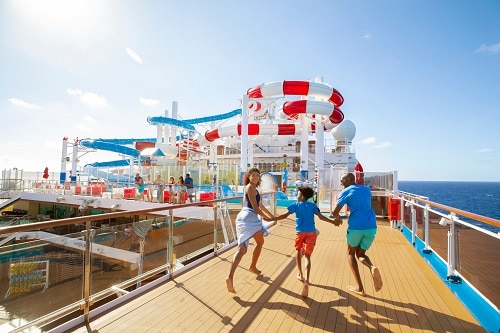
Choose Biodegradable Sunscreen for Your Shore Excursions
Many sunscreens protect your skin through two chemical ingredients, oxybenzone and octinoxate. These ingredients are safe for people, but not so much so for coral reefs. When the sunscreen washes off swimmers into the ocean, the chemicals cause damaging bleaching and infections that kill off reefs.
Luckily, there are alternatives to these non-biodegradable sunscreens. Mineral-based, biodegradable sunscreens with zinc oxide and titanium dioxide offer your skin protection from the sun while keeping nature safe because they have “non-nano” sized particles that coral reefs can ingest.
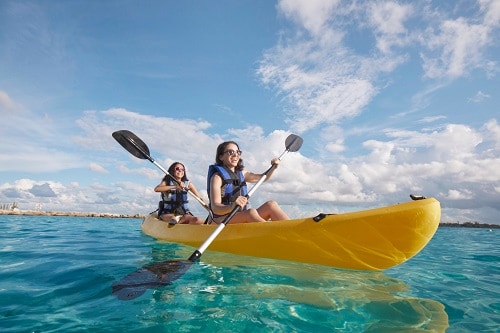
At Carnival, we care about the environment as much as we care about your fun, so we ask our cruisers to wear only biodegradable sunscreens for all beach and pool excursions.
This is an easy way to protect you and sustain the environment too. Here are just a few examples of our water-based excursions, but be sure to bring along only biodegradable sunscreens when you’re cruising to any of the many breathtaking cruise destinations that will bring you close to Mother Nature’s coastlines.
- Mexico’s ports of Puerto Vallarta and Cozumel
- Hawaii’s many shore excursions
- Sunny Key West, Florida
- The thousands of islands and cays of the Caribbean
- The Bahamas’ string of islands along the Atlantic
Carnival cruises are designed for endless fun. While you’re packing for your dream destination, use these tips to include a couple of types of sunscreen to protect your skin on board and on shore, and get ready to create some amazing memories.
Note: Onboard activities, shore excursions, and dining options may vary by ship and destination.
